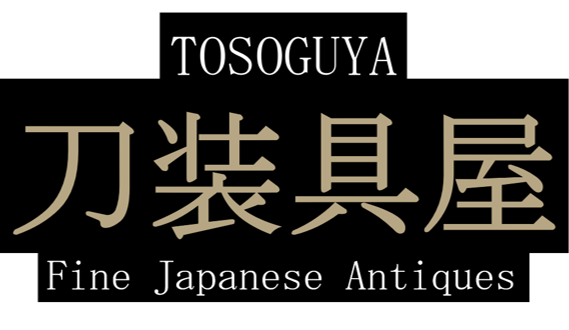

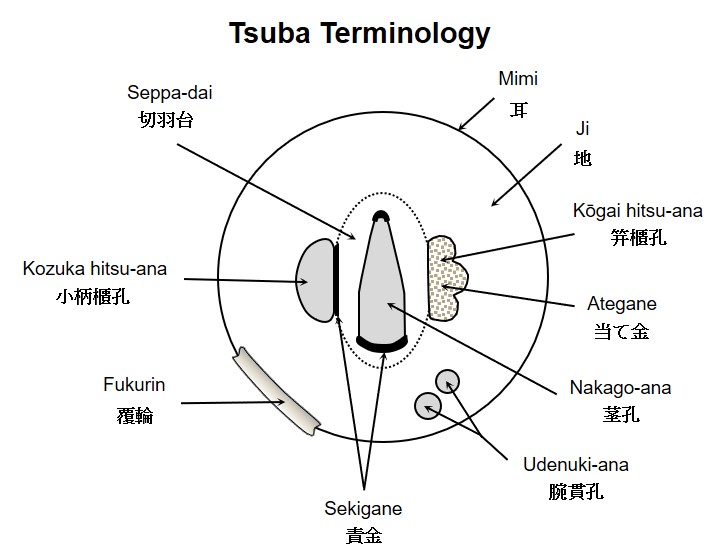
Ategane (当て金) - Metal plugs added to tsuba to fill the hitsu-ana
Fukurin (輪) - A rim covering, often but not always of soft metal
Hitsu-ana (櫃孔) - Opening or passage in the tsuba for purposes of accommodating some object. Respectively prefixed by kanji for kōgai-, kozuka- or nakago-
Ji (地) - As applied to tosogu, it refers to the ground surface or plate. Usally preceeded by a descriptor ie. Nanako-ji (魚子地)
Ji-sukashi (地透) - Positive relief openwork
Kage sukashi (影透) - Negative relief openwork. Occasionally called In-sukashi (陰透)
Mimi (耳) - The rim of a tsuba. Two types: Uchikaeshi-mimi or Dotte-mimi
Sekigane (責金) - Metal inserts applied to the hitsu-ana, in order to resize them to a smaller fitting blade or saya implement
Seppa-dai (切羽台) - Area on either side of the tsuba, surrounding the nakago-ana, which is covered by the seppa
Udenuki-ana (腕貫孔) - Pair of small holes, typically under the nakago-ana, used to thread a wrist-cord. In Satsuma koshirae, the holes are referred to as tsuba-dome-ana (鐔留孔), and were used to affix the tsuba to the kurigata, by means of a thin wire. This added security was to allow the user to think-twice before drawing the blade without cause
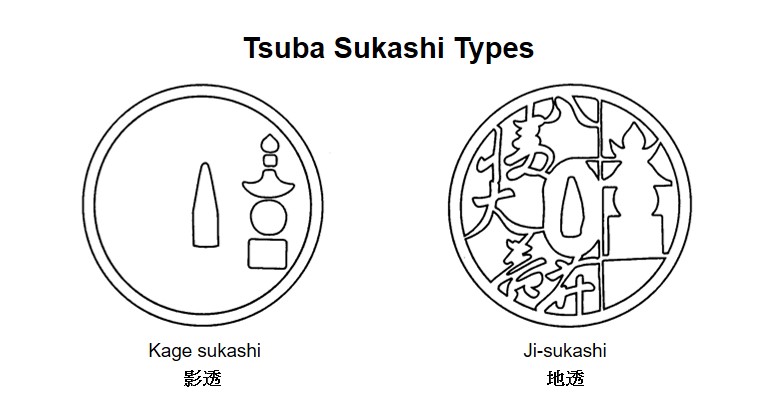
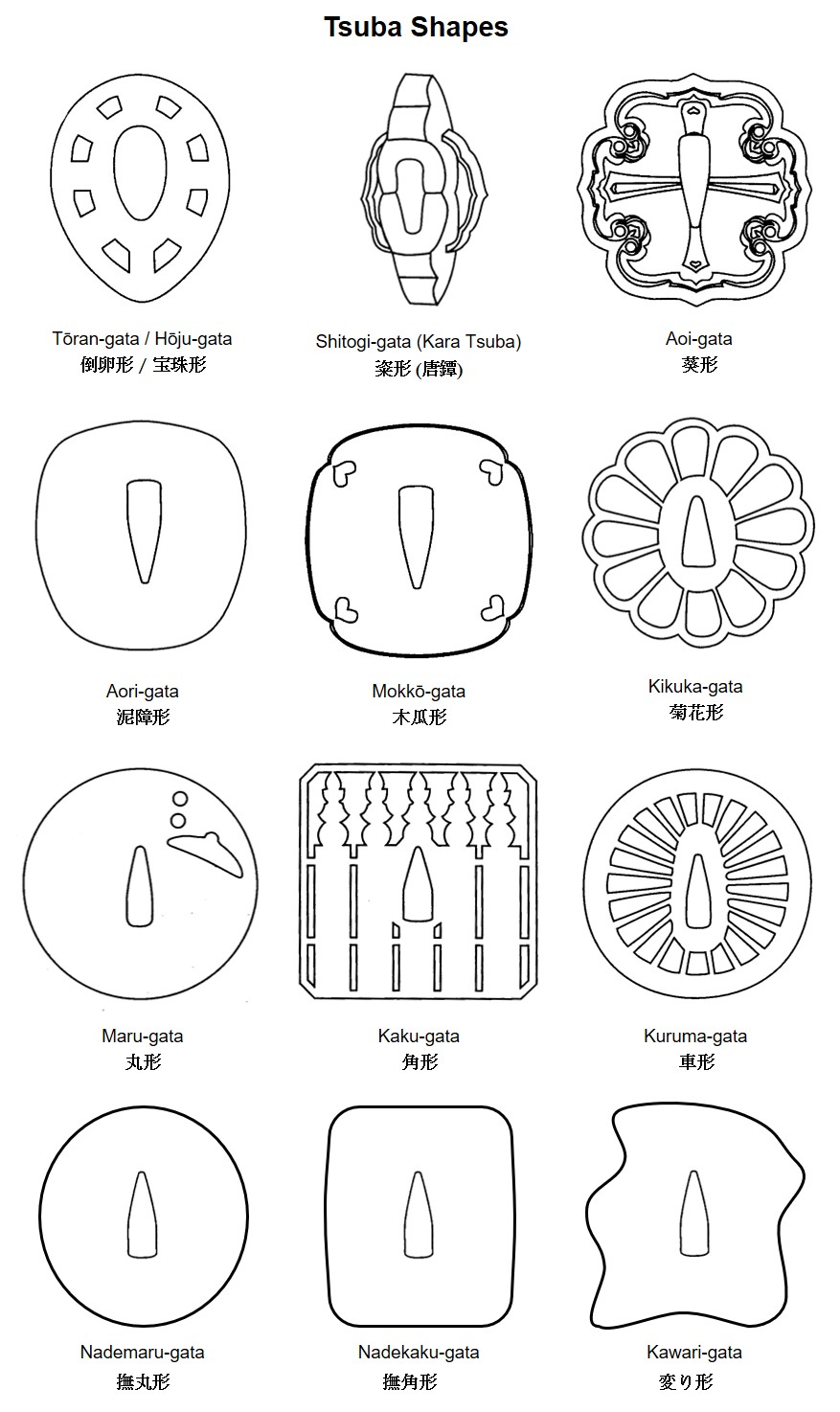
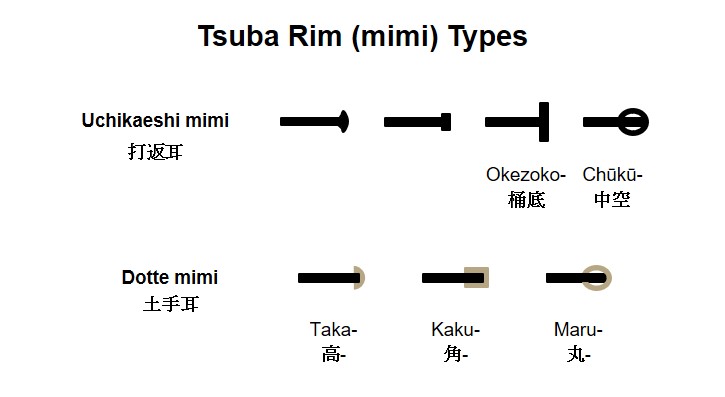
Aoi-gata (葵形) - Literally the 'hollyhock' shape. The classic shape for a tachi tsuba, very similar in form to the quatrefoil mokkō-gata tachi tsuba, but with peaked lobes
Aori-gata (泥障形) - Named after the shape of saddle bags, this tsuba form is slightly trapezoidal, with rounded edges. Generally it is associated with early tachi, and derived from the earlier Shitogi-gata tsuba. Some Jingo and Kanshirō works favoured this form
Dotte mimi (土手耳) - Tsuba rim where a metal band has been added in a strengthening capacity. Often made of the same metal as the plate. Sometimes described as an 'embankment rim' or 'piped rim'. Differs from a fukurin, which is ornamental, and typically of a different metal to than the plate
Inome (猪目) - Heart-shaped design elements, often as sukashi. Literally 'boars eye', in the Japanese design sense. Often added to the plate of Aoi- and Mokkō-gata shaped tsuba, at the apices of the 4 lobes
Kaku-gata (角形) - Square shaped. Numerous descriptors can be used to further differentiate nuances of form
Kawari-gata (変り形) - Unusually shaped tsuba
Kikuka-gata (菊花形) - Chrysanthemum shaped rim, typically with corresponding sukashi elements. Also seen as Kikka-gata
Kuruma-gata (車形) - Wheel inspired sukashi elements, combined with a straight rim (vs. Kikuka-gata)
Maru-gata (丸形) - Circular / round shaped
Mokkō-gata (木瓜形) - Quatrefoil shaped tsuba. Numerous variations of this style, each with descriptive names. This is also a classic early tachi form, along with Aoi-gata. Often associated with Inome (猪目) sukashi at the apices of the lobes
Nadekaku-gata (撫角形) - Most common variant of Kaku-gata form, with smoothed / rounded edges - an ovoid square
Nademaru-gata (撫丸形) - Sub-rounded shape - ovoid. One of the most common tsuba shapes
Shitogi-gata (粢形) - Meaning derives from a type of oval rice-cake . A form derived from the mainland, also referred to as Kara tsuba (唐鐔), denoting Chinese Tang dynasty origins. Characterized by a thick, hollow central section, with ear-like protrusions from each side (though not passing through). Evolved into the Aoi-gata tsuba, with the loss of the hollow middle section, in favor of the flat conventional plate
Tōran-gata / Hōju-gata (倒卵形 / 宝珠形) - Literally 'egg shaped'. These two forms mark the earliest domestically produced tsuba styles. Toran tsuba are distinguished by sukashi openings, while the Hoju tsuba are solid plate tsuba, and tend to be smaller
Uchikaeshi mimi (打返耳) - Tsuba rim where the plate edge has been hammered-back, beveled or shaped to thicken and strengthen the tsuba edge. The rim is the same material as the plate. Can be difficult to distinguish in some configurations vs the Dotte mimi (added rim), when the added rim is the same material as the plate ie. Chūkū-uchikaeshi-mimi vs. Maru-dotte mimi
Wan-gata (椀形) - Literally 'bowl' shaped. Concavo-convex form, said to have been modeled after European cutlass and rapier guards
The following list covers many, though not all common 'schools' or groups of tōsōgu. It should be understood that all of these schools are modern in concept, originating largely in the Meiji period, to satisfy the need of western collectors to differentiate and label various works. Many of these commonly used designations do not stand up to scrutiny, but they have become convention.
| Group | Kanji | Group | Kanji |
|---|---|---|---|
| Ko-Tosho | 古刀匠 | Awa | 阿波 |
| Ko-Katchushi | 古甲胃帥 | Iyo | 伊予 |
| Tachi-Kanagushi (Tachishi) | 太刀金具帥 (太刀帥) | Shonai | 庄内 |
| Ezo | 蝦夷 | Aizu | 会津 |
| Kagamishi | 鏡帥 | Akita | 秋田 |
| Kamakura | 鎌倉 | Kaga | 加賀 |
| Ko-Mino | 古美濃 | Bizen | 備前 |
| Ko-Goto | 古後藤 | Tosa | 土佐 |
| Onin | 応仁 | Satsuma | 薩摩 |
| Heianjo | 平安城 | Ko-Hagi | 古萩 |
| Yoshiro | 与四郎 | Soten | 宗典 |
| Ko-Shoami | 古正阿弥 | Hazama | 間 |
| Owari | 尾張 | Tochibata | 栃火田 |
| Kanayama | 金山 | Bushu | 武州 |
| Hoan | 法安 | Choshu | 長州 |
| Yamakichibei | 山吉兵 | Ito | 伊藤 |
| Nobuie | 信家 | Kinai | 記丙 |
| Kaneie | 金家 | Akao | 赤尾 |
| Umetada | 埋忠 | Jakushi | 若芝 |
| Ono | 大野 | Hizen | 肥前 |
| Saotome | 早乙女 | Tetsugendo | 鐡元堂 |
| Sadahiro | 貞広 | Ichinomiya | 一宮 |
| Myochin | 明珍 | Otsuki | 大月 |
| Haruta | 春田 | Iwamoto | 岩本 |
| Kyo-Kinko | 京金工 | Yoshioka | 吉岡 |
| Kyo-Kanagushi | 京金具帥 | Tanaka | 田中 |
| Akasaka | 赤坂 | Yokoya | 横谷 |
| Higo | 肥後 | Nara | 奈良 |
| Yagyu | 柳生 | Hamano | 濱野 |
| Nishigaki | 西垣 | Sano | 佐野 |
| Shimizu | 志水 | Omori | 大森 |
| Hirata | 平田 | Ishiguro | 石黒 |
| Hayashi | 林 | Murakami | 村上 |
| Nanban | 南蛮 | Nakagawa | 中川 |
| Mito | 水戸 | Kikugawa | 菊川 |
| Suruga | 駿河 | Kikuoka | 菊岡 |
| Hirata | 平田 | Someya | 染谷 |
| Tenbo | 天法 | Funada | 船田 |
| Kamiyoshi | 神吉 | Wada | 和田 |
| Sado | 佐渡 | Rinsendo | 臨川堂 |
| Term | Kanji | Comments |
|---|---|---|
| Mei (Zaimei) | 銘 (在銘) | Signature (signed) |
| Mumei (Meibun Mumei) | 無銘 (銘文 無銘) | Unsigned (Without signature) |
| Gimei | 偽銘 | False signature (fake) |
| Kao | 花押 | Makers seal |
| Den | 伝 | School /group affiliation ('in the style of') |
| Ryuha | 流派 | School / group |